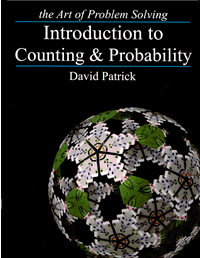Need help finding the right class? Have a question about how classes work?
Introduction to Counting & Probability Self-Paced
Summary
In this online class, students dive into the fundamentals of counting and probability, including casework, multiplication, permutations, combinations, Pascal's triangle, geometric probability, combinatorial identities, and the Binomial Theorem.
This advanced math course is offered in two formats: a live online course or a self-paced course. Both formats include instructor feedback, office hours, and a class message board for student support.
Introduction to Counting & Probability: Self-Paced
Length: 50 Lessons
In our self-paced Introduction to Counting & Probability course, students explore new concepts independently through a series of interactive, adaptive mathematical conversations.
Instead of prescheduled meeting times, self-paced math classes offer live interaction through the class message board, where students can connect with peers on challenging problems and receive support from instructors. We reinforce lessons with examples from the Introduction to Counting & Probability textbook, engaging videos, and various types of homework problems.
Although many students complete Introduction to Counting & Probability in 3–6 months, we offer unlimited class access for 9 months.
What's Included?
Why AoPS?
Innovative Interactive Instruction
In our self-paced courses, students progress through interactive lessons that engage them in mathematical conversations, guiding them step-by-step and addressing common misconceptions. Students learn in various ways, so we offer multiple learning avenues: interactive lessons, a textbook, videos, diverse homework problems, and opportunities to engage in discussions with instructors and peers on the class message board.
Active Learning
Learning is not a spectator sport, and students learn best by tackling hard problems themselves. Our lessons start with challenging questions to help students develop new mathematical strategies. If students get stuck, our learning technology supplies helpful hints and adapts lesson structure to further reinforce key concepts.
Focus on Non-Routine, Challenging Problems
To prepare our students for the challenges of tomorrow, we teach them how to apply fundamentals to different types of problems, not just variations on the same problem they’ve seen before. Building a critical problem-solving skill set, our students are prepared for the rigors of top-tier colleges and internationally competitive careers.
Who Should Take This Class?
Before taking this course, students should complete a basic algebra course, including linear equations and multi-variable expressions. Students who have completed Introduction to Algebra A or equivalent will have the relevant background to get started.
We strongly recommend this course for students interested in participating in math competitions such as MATHCOUNTS and the AMC 8/10/12. Introduction to Counting & Probability dives deep into ideas that are essential for contest success — and exploring them in greater depth might just be their next best challenge. Outside of math competitions, discrete math is the math of modern computing and helpful for STEM careers.
- To determine if you’re ready for the course, students can take the diagnostic pretest.
- To determine if you need this course, students can take the diagnostic post-test.
Self-Paced vs. Weekly Live
Our self-paced class is designed for students who prefer to set their own study schedule. In this format, students can engage with peers and receive support from staff through the class message board. For students interested in a live group experience with real-time interactions in an online classroom setting, we recommend considering the weekly live version of this course.
- Counting Lists of Numbers
- Counting with Addition and Subtraction
- Permutations
- Casework
- Complementary Counting
- Constructive Counting
- Counting with restrictions
- Permutations with Repeated Elements
- Counting Pairs of Items
- Counting with Symmetries
- Combinations
- Combinatorial Identities
- Paths on a Grid
- Distinguishability
- Applications of Chapters 1–5
- Definition of Probability
- Counting Techniques in Probability
- Probability and Addition
- Complementary Probability
- Probability and Multiplication
- Probability and Dependent Events
- Using Symmetry in Problem-Solving
- Probability Using Lengths
- Probability Using Areas
- Definition of Expected Value
- Problem-Solving with Expected Value
- Constructing Pascal's Triangle
- Pascal's Triangle as Combinations
- More Combinatorial Identities
- Distributions
- Sticks and Stones
- The Hockey Stick Identity
- Proving the Binomial Theorem
- Applying the Binomial Theorem to Problems
- The Binomial Theorem in Identities
- Applications of Chapters 7–14
Required Textbook
Related course: Introduction to Counting and Probability

















